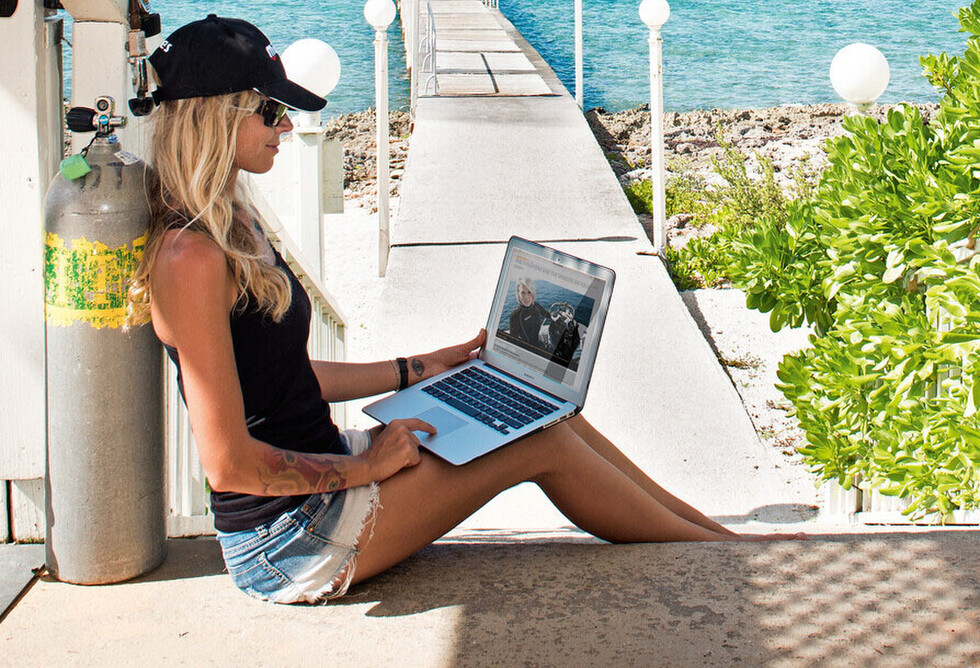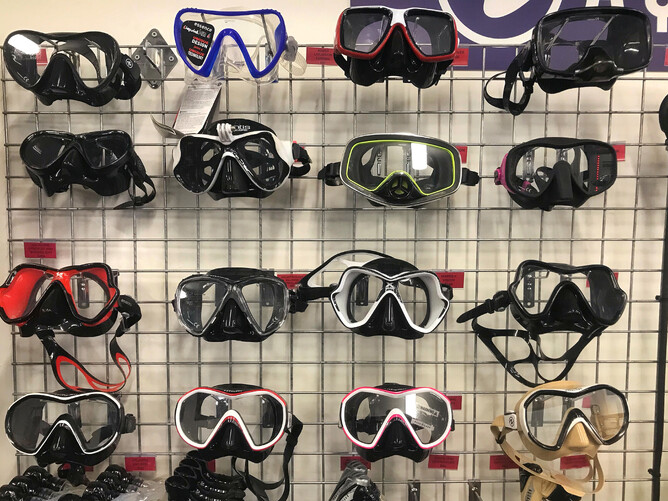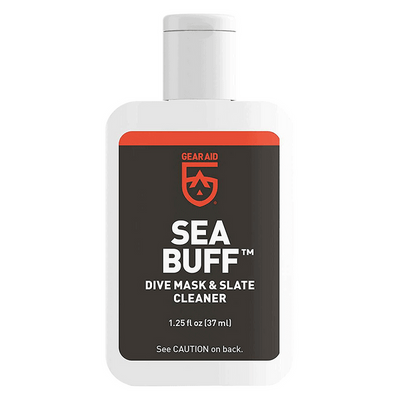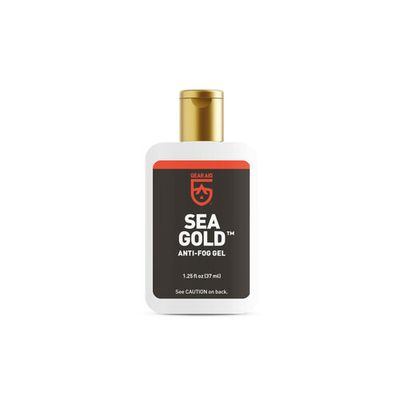The above image look familiar?
Your mask fogging up can not only be annoying, it can ruin your days diving and can also be dangerous. In this blog we will discuss what causes it and the best methods for preventing it happening to you. Make a cuppa and read on...
The mask is perhaps the most important piece of equipment you will use and own as a diver, because it allows you to take in the majestic beauty that is the underwater world. Masks come in many different shapes, sizes, and colors to suit the activity, the individual face, and of course the users personal taste, too.
A good mask makes diving a delight, a bad one can cause a few salty tears at best, but can even become a danger to the diver. Whether you are a scuba diver, a freediver, or a casual snorkeler, we are going to look at what we should take into account when choosing, purchasing, and preparing a mask.
How to choose a new mask
Choosing a new mask is one of the first things you are likely to do in your diving journey. This is because it is so frustrating to use a mask that does not fit right. It can be very daunting in a large dive shop with literally hundreds of masks to choose from to know which to go for. But we are here to help narrow down your search and make sure you get a good quality mask.
Lenses
Most masks nowadays have tempered glass lenses which is imperative for long term durability, and of course to protect the divers eyes in the exceptionally rare case that the lens might get broken whilst wearing the mask. It is typically written on the lens itself or through a safety standard kitemark whether the glass is tempered. Some freediving masks have plastic lenses but they are very specific for deep freediving, and not so suitable for recreational diving on the reef as they are likely to get scratched easily with lots of use.
Usually lenses are clear but there are tinted lenses and mirrored lenses available too. These lenses can be spectacular in photos but they often reduce the light passing into the mask, so clear lenses are usually a better option. Prescription lenses are also available with many brands of masks nowadays, as you obviously cannot take your glasses with you underwater!
Skirt
The skirt of the mask is important to consider as well, because it creates the seal that prevents water from entering the mask in the water. Nearly all masks nowadays are made from silicone, but the softness and quality can vary (often with price), as can the color. Black skirts are excellent as they do not discolor over time, you will see a lot of professional divers choosing black as they use their gear so often. However, clear silicone lets in lots of light which can be useful for underwater models or people who prefer to have more peripheral vision. There are also a multitude of colors now available so you might even be able to match your fins, snorkel, or wetsuit.
The perfect fit
The single most important part about choosing a mask is how it fits on your face. There is a useful technique to test whether or not a mask is suitable for you: Start by moving the strap over to the front of the lens, place the mask onto your face and make sure the skirt has a flat seal (no edges folded over) while also removing any hair that might get caught under the skirt, too. Do not put the strap over your head like you would in the water. Begin inhaling through the nose, and if the mask is suitable you should feel it create a suction against your face, and the mask will stay in position even without using the strap. If you can feel any air moving into the mask from the skirt seal, double check your positioning and try again (pro tip: look at the smaller secondary skirt inside the mask, if this is also sealed nicely against your face, you have a real winner). Those with facial hair might have difficulty achieving a seal as the bristles on the upper lip often get in the way, shaving and/or a healthy dab of vaseline can help with this.
Here are a few of our favorite masks to help narrow down your search:
For freediving: Go for a low volume mask for freediving, this will enable you to equalise the mask at depth without wasting too much of your precious breath hold. They now come in a wide selection of colours and styles and correct fit is everything.
For snorkeling: Of course you pay for what you get so go for the best your budget will allow but if your only going to be doing a little snorkelling on your annual holiday overseas you don't really need to spend a huge amount and there are some really cost effective snorkelling pack options which won't break your bank account.
For scuba diving: A super soft silicone mask with large lenses is the way to go, that way you will have good peripheral vision to keep an eye on the reef, yourself and your dive buddy. For guys who often have larger brows than girls a good choice is a frameless option, for everyone else frameless or twin lenses work well. Remember colour and style are everything so try a few on and see what fits well and looks good.
Finally take the good advice off a professional (dive instructors), and what we mean by that is someone who is regularly diving and has extensive experience in the diving industry, anyone else is just a salesperson trying to earn a quick buck.
How to prepare your new mask
When masks are manufactured a very thin film of silicone is coated on the inside of the glass. If this is not removed then the mask will always fog in the water. One way to remove this film is to use a lighter to burn it off. We definitely do not recommend doing this (unless you really know what your doing) as it is easy to crack the lenses due to excessive heat and even easier to melt the delicate silicone skirt (this will cause the mask to leak water).
You may have heard toothpaste will work, well this is really an old school idea that doesn't really work. Back in the day, toothpaste used to contain Bicarbonate of Soda and it was this abrasive compound that kept your teeth pearly white, we now know that is also wears the protective enamel off your teeth so most toothpastes sold today are just gels and they won't help your foggy mask situation. Also have you ever got toothpaste in your eyes? Try it, you definitely won't want it to happen whilst you are underwater!
By far the safest, easiest and best way of getting rid of the fog is to use a proper, purpose designed mask cleaning compound and this method we recommend to ALL our customers in-store purchasing new masks. (click on the images below for more info).
To use this cleaner, first of all put the kettle on, make a brew, find a comfy seat and remember a little goes a long ways:
Put a drop about the size of your small finger nail onto the inside only of each lense. (you don't need to scrub the outside).
Spend about 5 minutes rubbing the compound into the lense
Rinse in warm water
Repeat three times
After the mask has been cleaned it is good practice to give them a fresh scrub perhaps every three months. This will keep it nice and clean and fog free.
Once you have purchased, prepped, and personalized your mask it is time to dive! But there is one more step to make sure you have the best experience: Preventative defog! Defogging solutions are available to buy at many SSI dive centers and can be used on your mask to keep it clear while diving. (spitting in your mask is not good quality and is gross). Again we use a tried and tested product which we love (and you will), GEAR AID Anti fog gel.
If you are in a warm climate and diving in cold water (i.e Aotearoa), the rapid change in temperature can also cause fogging, try to avoid wearing your mask for too long before submerging as this will speed up the fogging effect as the sun heats the air inside the mask rapidly.
Of course nothing is 100% fool proof, and occasionally we will get some mask fogging during a dive. Snorkelers and freedivers can take the mask off at the surface and add a bit more Defog solution. Scuba divers who are already underwater can allow a small trickle of water into the mask while looking down which can help a little with defogging. If this does not work, you might want to fully flood your mask before clearing it, just like you practice d during your Open Water Diver program. Remember to hold the bridge of the mask against your eyebrows and exhale through the nose as you tilt your head backwards. This might require your buddy’s assistance with this, and make sure to take your time and do it a few times if needed. Practice makes perfect!
If you are worried about your mask fogging on a dive, it is a good idea to take a spare with you in your BCD pocket, to prevent you from having to end the dive early. Good divers and safe divers will always be carrying a back-up mask somewhere, its all about redundancy huh?
We hope you learnt something new and we hope you can now see clearly on all your future dives! Until next time...




